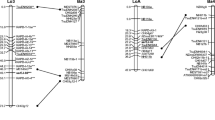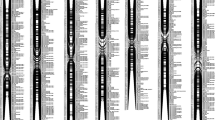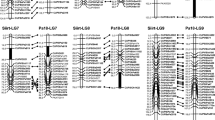Abstract
A map with 51 markers (46 RFLPs and five isozymes) was constructed using an interspecific F2 population between ’Garfi’ almond (Prunus amygdalus Batsch.) and ’Nemared’ peach [Prunus persica (L.) Batsch.]. This map was developed by selecting markers covering most of the distance of the eight linkage groups from previously constructed Prunus maps. The markers studied in this population mapped to seven linkage groups instead of the eight expected in Prunus. Markers belonging to groups 6 and 8 in previous maps formed a single group in the ’Garfi’×’Nemared’ F2 and several marker pairs placed in different groups in other maps exhibited tight linkages. The study of pollen fertility and chromosome behavior during meiosis in the F1 generation allowed us to confirm the hypothesis that a reciprocal translocation exists between ’Garfi’ and ’Nemared’. Based on independent evidence of linkage between markers and pollen fertility data in the F2 population, we concluded that the breakpoint of the reciprocal translocation was placed between markers AC50 and AG26A in group 6 and between markers AG112A and FG230A in group 8.
Similar content being viewed by others
Author information
Authors and Affiliations
Additional information
Received: 28 June 2000 / Accepted: 17 October 2000
Rights and permissions
About this article
Cite this article
Jáuregui, B., de Vicente, M., Messeguer, R. et al. A reciprocal translocation between ’Garfi’ almond and ’Nemared’ peach. Theor Appl Genet 102, 1169–1176 (2001). https://doi.org/10.1007/s001220000511
Issue Date:
DOI: https://doi.org/10.1007/s001220000511




